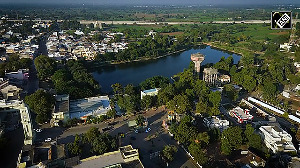There is a cluster of three buildings in Gurgaon that one can easily lose in the landscape of this Delhi suburb. But once inside, you cannot miss the smell of white powder or the rustle of some 1,400 lab coats.
From this cluster, the heart of Ranbaxy Laboratories' research and development, is likely to emerge India's first new chemical entity, industry jargon for a new drug molecule that can be patented.
"I believe that our malaria molecule will be the first NCE to come out of India successfully by 2011," says Ranbaxy's chief executive Malvinder Mohan Singh.
The drug, RBX11160, developed with NGO Medicines for Malaria Venture, is undergoing Phase IIB dose range finding studies in India, Thailand and Africa.
It may be pipped to the post by DRF2593, the anti-diabetes molecule developed by Hyderabad-based Dr Reddy's Labs.
Both have suffered setbacks in the past - Ranbaxy's molecule licensed to Schwarz Pharma, and two of Reddy's farmed out to Novo Nordisk and Novartis, failed during clinical trials.
Undaunted, Indian companies continue to chase the NCE dream. They have made a few breakthroughs in generics and novel drug delivery systems, such as, Ranbaxy's once-a-day Ciprofloxacin.
In the last two years, though, the top guns have devoted themselves to NCE development, with encouraging results.
Apart from the anti-malaria molecule, Ranbaxy is developing two with GlaxoSmithKline and seven others on its own.
Dr Reddy's has nine in various stages between toxicity studies and final human trials. Glenmark has six: two in Phase II trials, one in Phase I and three in pre-clinical.
Wockhardt too has six in the pipeline, of which the most advanced is in Phase II human clinical trials.
Part of the reason is the advent of product patents in India in 2005. The swelling crowd in the industry - 20,000 pharma companies at the last count, all into generics - and more accessible but patent-conscious global markets are other factors.
Impetus also came from overseas. In most years in the 1990s, the global industry spent $35-40 billion on R&D and came up with 35-40 new drugs. Now, annual spending has crossed $60 billion, but the number of new drugs has still to grow.
"The productivity and final output can be much higher," says Singh.
Increasingly, smaller companies are taking more risks. The malaria drug that Ranbaxy is working on was first being developed by Roche of Switzerland, which apparently lost interest in this developing-world affliction.
"Europe was the cradle of discovery from the 1940s to the 1970s, then the US and then Japan in the 1980s-90s. India is at the same stage now as Japan was then," says R Rajagopalan, president, discovery research, at Dr Reddy's.
That holds out immense promise. For now, though, an indigenous NCE by an industry for long derided as copycats for relying on reverse engineering, will do, at least to stem some of the derision.





